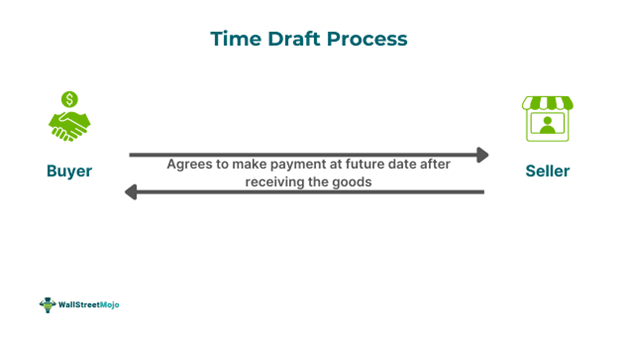The differences between both the concepts are given as follows:
Table Of Contents
What Is Time Draft?
A time draft, also known as a date draft, is a type of payment instrument that must be paid at a later time, usually after the buyer receives the products. It is used in international trade and gives the buyer a short period to complete the necessary payment after making the purchases.

Such drafts are necessary for international trade because they give sellers a way to give buyers credit. They give merchants a degree of certainty that payment will be made while allowing purchasers the flexibility to defer payment until a later date. The short period before payment gives buyers some time in case of tight financial situations.
Key Takeaways
- Time drafts, often called date drafts, are drafts that need to be paid for later. They are usually issued after the customer has ordered the goods.
- International trade requires drafts because they allow sellers to extend credit to purchasers. Buyers who are in difficult financial conditions might take advantage of the short payment period.
- The transmittal letter, which offers comprehensive instructions on how to handle the documents and make the payment, is what the parties rely on. These drafts or credit letters protect the interests of buyers and sellers.
Time Draft Explained
A time draft is a written agreement that confirms a commitment to pay after a predetermined amount of time. It gives the buyer additional time to make the payments after ordering and is typically used in international trade. Thus, it is a short-term credit arrangement for the buyer.
The parties depend on a transmittal letter, which provides detailed instructions on how to handle the documents and make the payment. These drafts or letters of credit safeguard the interests of both purchasers and sellers. Payment for either method must be made upon presentation of documents that transfer ownership and verify the completion of specific actions.
In international trade, exporters may not be sufficiently familiar with the importer or buyer to guarantee payment. A bank will accept a time draft for the buyer on their behalf; this is referred to as a banker's acceptance, and it is usually done for a fee. With payment made in accordance with the draft's timeliness, the exporter ships products based on the bank's goodwill and guarantees.
The exporter is legally required to receive payment from the bank on the due date. When the bank knows the importer well and has old terms with them, it may choose to hold off on payment until the maturity date, giving the buyer time to inspect the products before completing the payment. Before providing a banker's acceptance, the bank may demand payment in full from the importer.
Examples
Let us look into a few examples to understand the concept better.
Example #1
Let's say that Company A in the US exports products to Company B in the United Kingdom. Under the terms of the trade agreement, Company A executes a time draft directing Company B to pay 20 days after the shipping documents are presented. As a result, Company A is guaranteed payment in the future, and Company B is able to get the items prior to making the payment.
Example #2
Suppose Company A, an electronics manufacturer based in the United States, has received an order from Company B, a retailer in Africa. The trade terms were discussed, including the payment method. So, they explore further international payment options such as Documentary Collections, cash in advance and letters of credit, open account transactions, consignment, etc. Initially, Company A suggests cash in advance payment, but Company B finds it financially burdensome.
Company A proposes a letter of credit as an alternative, but Company B has concerns about complexity and convenience. At the end of the discussion, both parties settled on a date draft. To address these concerns, Company A suggests a 60-day time draft, allowing Company B to make payment within 70 days of receiving shipping documents. Company B agrees and appreciates the extended credit terms. The goods are delivered, and Company B makes the payment within the agreed time frame.
Time Draft Vs. Sight Draft
| Points | Time Draft | Sight Draft |
|---|---|---|
| 1. Concept | It is a bill of exchange that has payments set for a future date. | A sight draft is a type of draft or bill of exchange where immediate payment is required. Having stated that, it does not imply that payment will be made right away. |
| 2. Advantage | The seller receives guaranteed payment for the goods, which is one of the key benefits in this case. | The exporter maintains ownership of the goods until payment is received, which is an advantage of the sight draft. |
| 3. Disadvantage | There is a chance of higher risks when payments are not made on time. | A sight draft has the disadvantage of not paying an exporter for goods until the appropriate importer receives them. |
